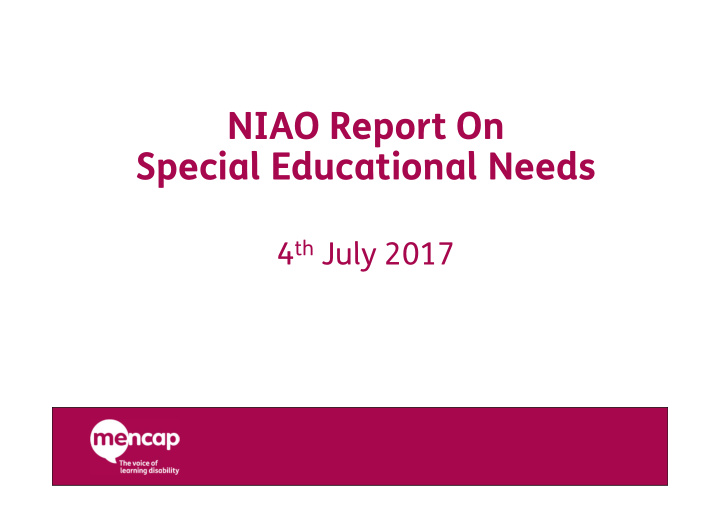



NIAO Report On Special Educational Needs 4 th July 2017
Special educational needs (SEN) can affect a child’s ability to learn and they may require extra help to achieve their full potential. 2011 – 2016 21% increase number of children SEN Estimate 76,300 children have SEN (not always statement) 63% Children with SEN are male and 27% female Improvement in fewer children leaving no formal qualifications and more going HE/FE
Early Identification & Intervention For all children the first 0-5 years are the most crucial for laying the foundations for future, allowing children to reach their fullest potential.
Key findings in the report • Early identification of developmental delay or difficulties is critical. • 2009 ETI Survey - diagnoses at an early stage within pre-school was too much of a ‘lottery. • Cross departmental approach on early identification was ‘yet to be realised in a consistent manner’. • ETI evident different variations and methods across schools to identify children with SEN. • 2004/4 – 40% pupils SEN in special school 2016/17 30%.
Cross Departmental Approach to Statementing Key Findings • EA statutory assessment of need is a detailed multi-disciplinary assessment to find out what provision is required. • EA must seek professional advice from educational psychology, educational advice, medical and social service advice, as well as parental submissions. • 79% new statements were issued outside the 26 week timeframe. • EA - provide a breakdown of the reasons for delays • DE established Project Board with DoH - improving co- operation in relation to SEN.
Training - Key Findings • Role of the Special Educational Needs Co-Ordinator is vital, but not always given enough time or authority to effectively carry out duties. • DE Review highlighted lack of appropriate training as an issue for SENCOs and in some instances not all SENCOs have been trained. • Establish the SEN in-service training requirements for all staff in terms of good, regular pratical training in SEN identification and provision for all staff not just SENCOs.
Expenditure Key Findings • Inconsistencies in-relation to SEN spend meant not able to get a full breakdown.
Monitoring / Evaluation - Key Findings • Ofsted (2010) “In addition to good teaching, the keys to good outcomes were close tracking, rigorous monitoring of progress with intervention quickly put in place and a thorough evaluation of the impact of additional provision. • 10 years since ETI evaluated SEN. • ETI - evaluation of SEN provision including need for future training and effectiveness of early intervention strategies. • Department and EA must assess the quality of SEN support provided in mainstream schools by formally evaluating the progress made by children.
Conclusion • The report and recommendations should extend to Special Educational Needs Schools. • Address the postcode lottery of service provision. • Need disaggregated data in terms of child centred progression according to Special Educational Need. • A clear pathway of statementing process needs to be widely promoted and include families within the process. • A full and open review on how EA and DE can robustly assess and evaluate Special Educational Needs provision in both Special Schools and Mainstream Schools.
Thank you Margaret.Kelly@Mencap.org.uk
Recommend
More recommend